Filtration
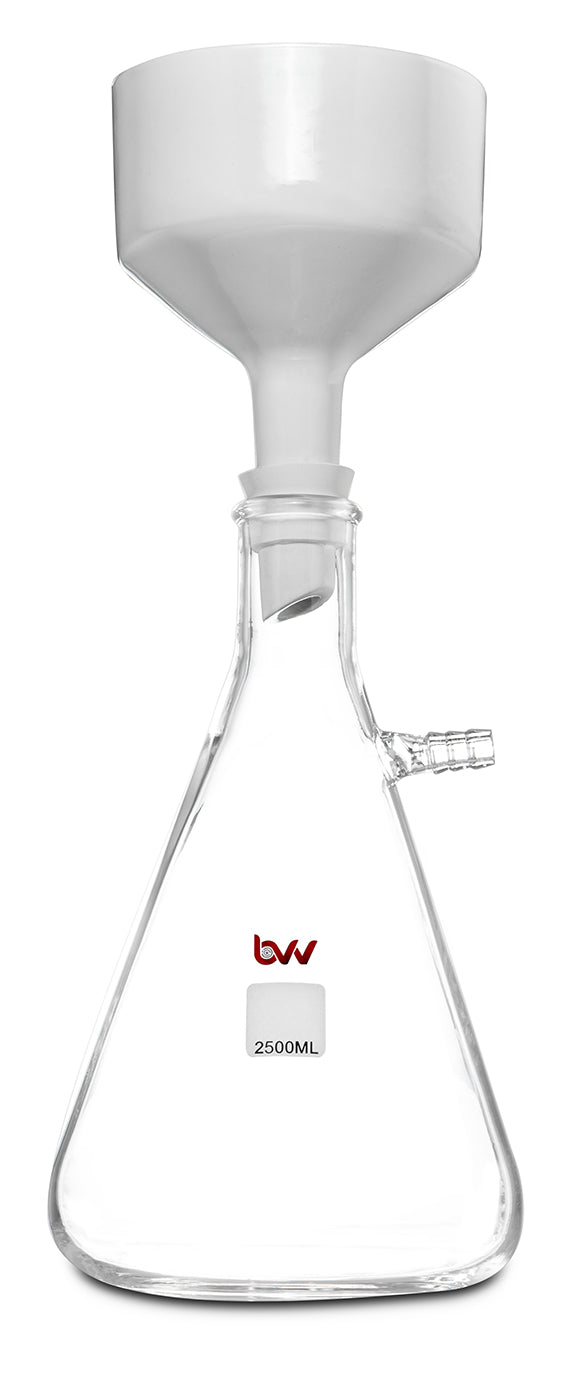
Porcelain Buchner Funnel Kit
This porcelain buchner funnel kit includes a 3.3 borosilicate non-jointed conical flask with side port hose barb, porcelain buchner funnel in either 1000 or 2000ml and a 9 piece rubber cones set to create the seal between the flask and the funnel. Each kits includes the following: 1000ML: (1) - 1000ml Porcelain Buchner Funnel (1) - 2500ml Conical Flask Filtering with Internal Side Arm (1) - Rubber Cones Set of 9 2000ML: (1) - 2000ml Porcelain Buchner Funnel (1) - 5000ml Conical Flask Filtering with Internal Side Arm (1) - Rubber Cones Set of 9
$125.00 - $140.00

Color Remediation Column CRC w/ Bypass
Color Remediation Column w/ Bypass The CRC is a secondary column used as a filtration cartridge for hydrocarbon and ethanol extraction systems. Filter medias are packed in the column above a triple filtration stack, which aids in the removal of impurities from extracted oils. The CRC features a bypass path, allowing the operator to skip the column in case of a clog. The color remediation process is made simple by bundling the cartridge with the needed filter medias. We have paired the unit with suggested media, supplied in the proper ratio, and a standard operating procedure. The included procedure takes all the guesswork out of filtration, delivering the desired results the first try. Our CRC comes available with 1/4",3/8", and 1/2" MJIC connections, your choice of a 3",4", and 6" diameter spool with a 12" height, and rack mounting brackets standard to accommodate systems of any size. This Kit Includes: Color Remediation Column Rack Mounting Brackets 100 pack of 8 and 20-micron filter papers 1000g or 2.5 kg of Activated Alumina 1000g or 2.5 kg of Silica 60A 1000g or 2.5 kg of Pure-Flo® B80 (81, 5000, 6000 or Color Bleach)*Substitutes 1000g of Celite®545 Instruction Manual
$850.00 - $1,350.00
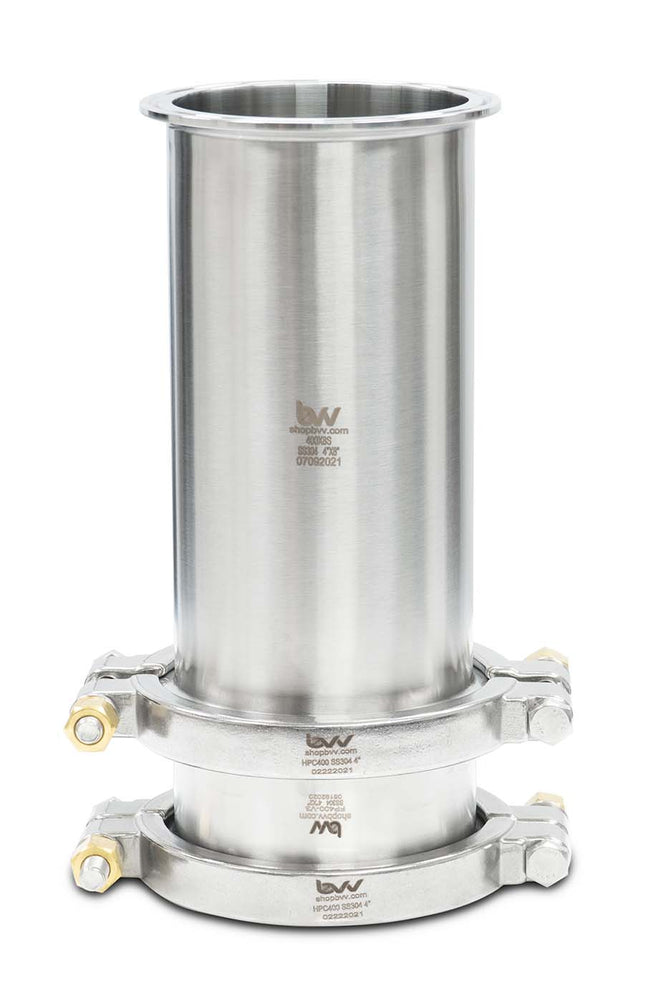
Inline CRC
Inline CRC Kit BVV's Inline CRC Kit can be utilized to adapt any 1.5", 2", 3", 4", or 6" diameter material column for inline adsorbent filtration. This kit includes a corresponding sized media column and a filter stack including a 5 micron & 1 micron Dutch Weave Sintered Filter Disc. This Inline color remediation kit is meant to be plumbed between your existing extractors material column and the existing hemispherical reducer of any closed loop hydrocarbon extractor.Assembly starts with placing the 1 micron sintered disk and gasket between the extracts hemispherical reducer and the included filter plate securing both with one of the included high-pressure clamps. Next, take the 5-micron sintered disk and the included ashless filter paper and rip around the circumference of the sintered disk, placing both atop the filter plate placing the sintered disc gasket and media column spool over top before securing both with the remaining high-pressure clamp. Since the spool secures the filter paper in place a filter plate ring is not required. Media can then be layered into the media column by weight before placing the loaded material column above the adsorbent filtration column and assembling the remainder of the extractor. For optimum filtering results utilize the following layer recipe from top to bottom: 30-50g per lb of biomass Silica 60A 75-100g per lb of biomass Bentonite Clay 30-50g per lb of biomass Neutral Activated Alumina This Kit includes: Media column Tri-clamp Spool V3 Filter Plate 5 Micron Sintered Disk 1 Micron Sintered Disk 2X Buna-N Sintered Disc Gaskets 2X High-pressure Clamps Fast Flow Ashless Filter Paper (100qty) 1000 Gram Sample of B80 *This video provides a visual assembly of the 3" Inline CRC which is applicable across all sizes*
$145.00 - $427.00
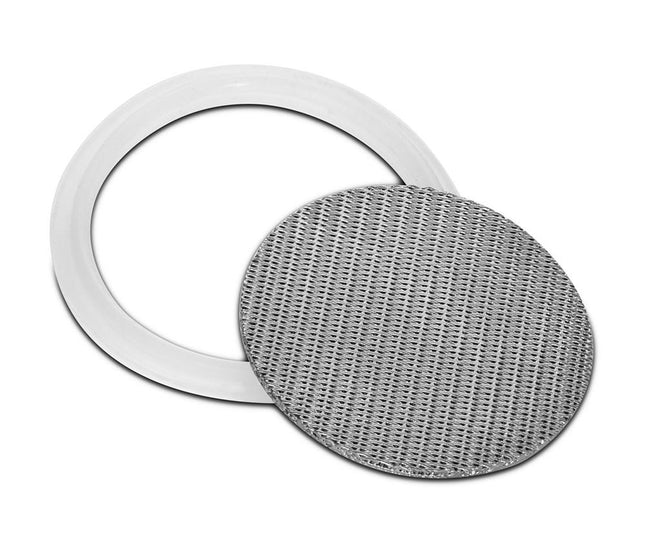
316L Stainless Dutch Weave Sintered Filter Disk 1 micron and up - Silicone
316L Dutch Weave Sintered Filter Disk **Note: This product comes with Filter Disk and Gasket ONLY. Filter Plate and Spool are NOT included. Recommended Filter plate click here. These 316L stainless steel dutch weave filter disks come with a custom made gasket to allow the user to insert filtration between clamping ends of any Tri-Clamp interface. The interface fits so snug, its inherent design prevents any blow-by. Sintered Filter Disk Technical Data Sheet Pressure Ratings w/o any backing support; strait pipe connection: 1.5" 200PSI 2" 200PSI 3" 200PSI 4" 200PSI 6" 50PSI 8" 10PSI *Supporting Back Plate Required P# FP800-V3 10" 10PSI *Supporting Back Plate Required P# FP1000-V3 12" 10PSI *Supporting Back Plate Required P# FP1200-V3
$30.00 - $500.00
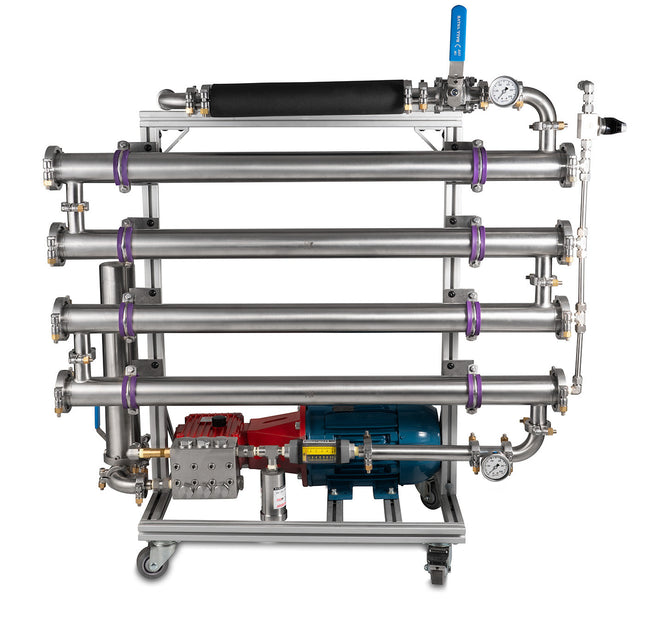
BVV 2540 Nanofiltration Skid
BVV 2540 Nanofiltration Skid Note: This product carries 8 - 12 week lead time Perform organic solvent recovery or botanical extract decolorization with ease with our 2540 nanofiltration skid. BVV's 2540 Nanofiltration Skid is designed to meet Class 1 Division 1 standards. With the ability to recover 30 gallons of ethanol per hour without the application of heat preserving target compounds and utilizing a fraction of the energy consumption of a traditional falling film. Processing Power Capacity: 30 GPH, 15 GPH, or 45 GPH of solvent recovery. Solvents: Denatured Ethanol, Potable Ethanol, Methanol Specifications 4X 2540 nanofiltration housings Stainless steel 6GPM pump with EPDM seals 5HP C1D1 1750 RPM Motor 5HP VFD 3/60/230 NEMA 4X enclosure (13A) Insulated 2"x18" Heat Exchanger Polyscience 1.5HP Chiller 230/60/1/23.1 700PSI Pressure Relief Valve C1D1 Flowmeter 2X 0-1000 PSI Pressure Gauges 1.5" Intake & Retentate Lines 1/2" Permeate & Pressure Relief Lines Footprint (DxWxH) 30"x39"x79" Weight: 400 lb Maximum Pressure Rating: 700PSI Performance Variable Frequency Drive-based flow control Complete pressure control with manual pressure controls Retentate cooling with inline Heat exchanger & chiller 700PSI pressure relief valve with diversion line *Components shown are subject to change**This unit is meant for bulk solvent recovery, 90% of the total volume of solvent an additional solvent recovery apparatus is recommended to evaporate to dryness*
$37,000.00 - $39,000.00
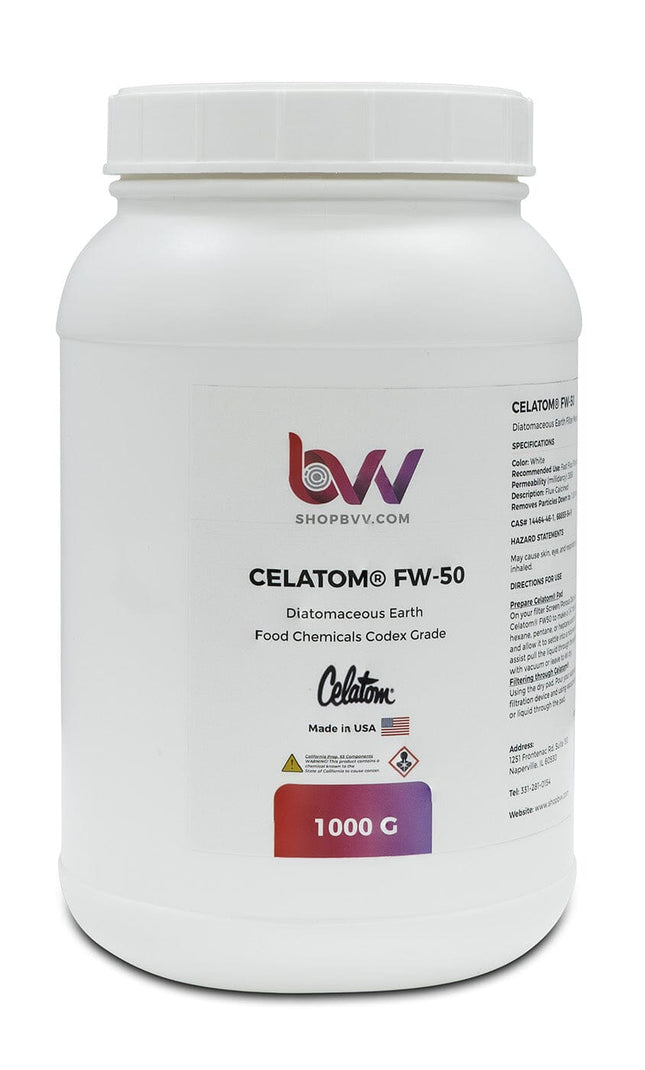
Celatom FW-50 Diatomaceous Earth 1.85 micron (Compares to Celite 545)
Celatom® FW-50 Food Codex Grade, Compare to Celite® 545 Filters particles down to 1.85 micron This filter aid is a white flux calcined diatomaceous earth. It has a fast speed filtration rating. Its applications At BVV we like to use Celatom FW-50 for CBD de-fat filtration in any of our Refinement Filters. Above our paper filter, we build a 1/4"-1/2" bed of media that we use to clarify and separate winterized waxes out of our ethanol from the winterization process. We prefer this over just the filter paper because it results in less clogging and more run time. Some other applications are wort beer, antibiotics, casein, pressed juices, lacquers, polymers, syrups, sorghum, varnish, water, corn gluten, citric juices, chemicals, resins, enzymes, enamels, kelp, plastics, shellacs, and corn syrup to name a few. Celatom FW-50 Technical Data Sheet Celatom FW-50 Food Grade Information Celatom FW-50 Safety Data Sheet
$17.00 - $129.00
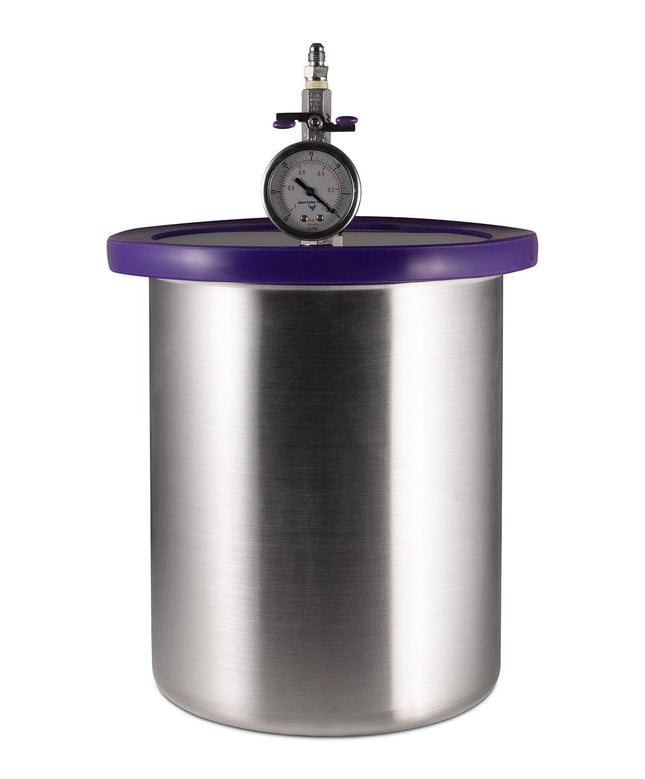
3 Gallon Stainless Steel collection Base
3 Gallon Stainless Steel Collection Base The standard collection base for our benchtop 1-micron Refinement filter. This 3-Gallon Collection Base is made from the highest quality 304 stainless steeland can be adapted to collect filtrate from a variety of small scale filtration apparatuses from traditional buchner funnels to refinment filters. Comprised of glass & stainles steel components this collection base is compatible with a variety of different solvents & solutions. This Collection base pairs nicely with our 1 Micron Refinement filters, diaphragm vacuum pumps or our line of spark-free vacuum pumps when paired with a cold trap. Specifications Collection Capacity: 11.35 Liters/3 Gallons 3 Gallon Stainless Steel Collection Base 10.75" Glass Lid with silicone gasket 1/4" JIC Collection Port 1/4" JIC Butterfly Vacuum Valve Back Mount Vacuum Gauge
$190.00
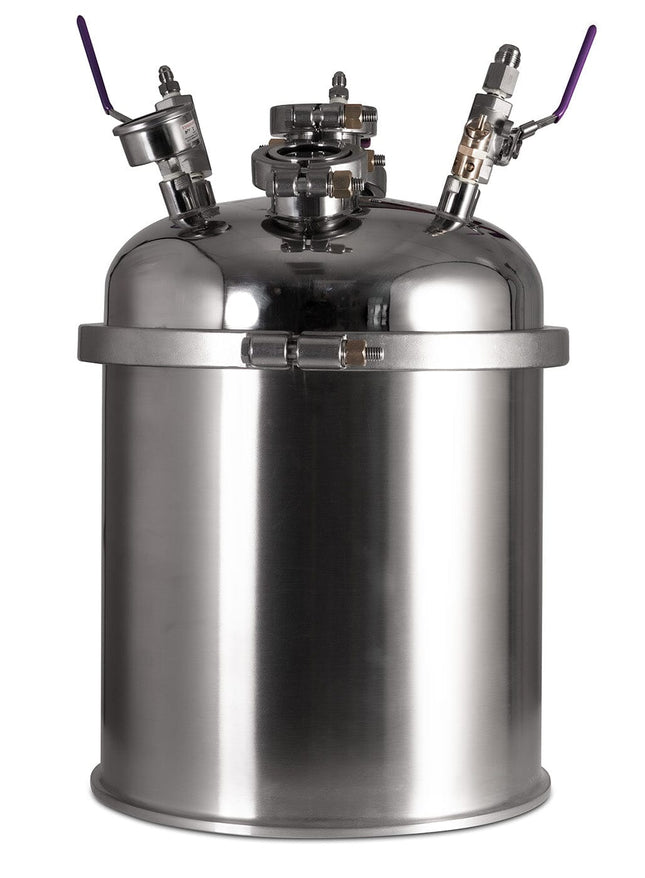
12" Collection Base
Pre-Built 12" Collection Base Double your capacity or configure your own custom system with BVV's Pre-Built 12" Collection base. Available in three different variations to suit your application all models of BVV's Pre-Built 12" Collections Base comes standard with high-pressure clamps, borosilicate sight glasses, and full-bore ball valves. Version 1 is the base model equipped with the standard 12" welded base perfect for cost-conscious applications. Version 2 is equipped with a 12"x12" spool & 12" splatter platter to make extract harvesting a breeze, and Version 3 is the top of the line 12" Colleciton base equipped with a 12" jacketed splatter platter for both optimized solvent recovery and ease of harvesting extract. Specifications High Pressure Clamps 2X 2" Borosilicate Sight Glasses 1X 125 PSI ASME Safety Valves 1X -30hg-250PSI Compound Pressure Gauge 1X 1/2" JIC Lid Valve 2X 1/4" JIC Lid Valves Maximum Pressure Rating: 125PSI Variations V1 : 12x12 Base (1200X12B) V2: 12" Splatter Platter base (1200X12S+1200SPL) V3: 12" Jacketed Splatter Platter Base (1200X12S+1200FJS)
$917.00 - $1,291.00
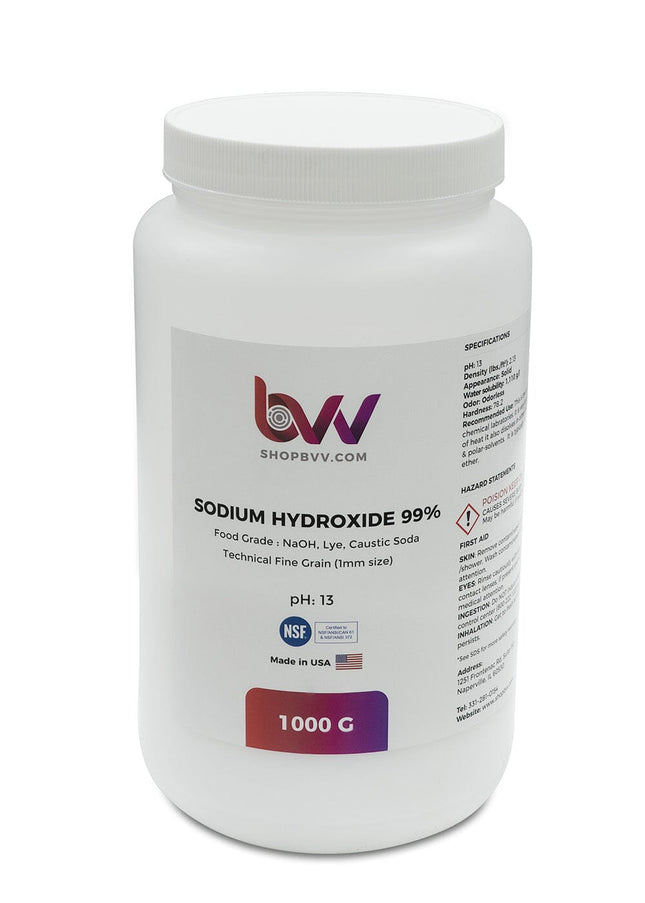
BVV™ High Purity Sodium Hydroxide 99% (Food Safe Chemical)
BVV™ High Purity Sodium Hydroxide 99% NSF Certified (Food Safe Chemical) Sodium Hydroxide is a highly versatile compound that finds extensive use in various applications, including acid-base extractions. As a strong base, Sodium Hydroxide is used to adjust the pH of aqueous solutions, making it an ideal choice for separating acidic and basic compounds during extraction. Also known as caustic soda, Sodium Hydroxide is a highly alkaline compound that is used in a wide range of applications beyond extraction including manufacturing, cleaning, and water treatment. At BVV, we pride ourselves on offering only the highest-quality chemicals and compounds, including Sodium Hydroxide. Our Sodium Hydroxide is a premium-grade product that is manufactured to the highest standards, ensuring exceptional quality and performance for your pH adjustment needs. Our Sodium Hydroxide is NSF certified as a food safe chemical, which means it can be used in a variety of applications including drinking water and is evaluated safe for consumption.Our product is available in a range of sizes and quantities to suit your needs, and our team is always on hand to provide expert advice and support. High Purity Sodium Hydroxide Safety Data Sheet SDS High Purity Sodium Hydroxide Certificate of Analysis COA Chemical Formula: NaOH Molecular Weight: 39.9971 g/mol CAS Registry Number: 1310-73-2 Appearance White, hard (when pure), opaque crystals Odor: Odorless Density 2.13 g/cm3 Boiling Point: 1388°C / 2530°F Solubility in water: 418 g/L (0 °C)1000 g/L (25 °C)3370 g/L (100 °C) GHS Pictograms: GHS Signal Word: Danger GHS Hazard Statements: H290, H302, H314 GHS Precautionary Statements P280, P305+P351+P338, P310 UN Identification Number: 1823 Proper Shipping Name: Sodium Hydroxide, solid Transport Hazard Class: 8 Packing Group: II DOT Placard: What Is Sodium Hydroxide? Sodium hydroxide, commonly known as lye or caustic soda, is a highly versatile and strong alkaline compound. It is represented by the chemical formula NaOH and consists of one sodium (Na+) ion, one hydrogen (H+) ion, and one hydroxide (OH-) ion. Sodium hydroxide is a white, odorless solid at room temperature and is highly soluble in water, producing a highly alkaline solution. It is widely used in various industries and applications, including manufacturing, chemical processes, cleaning agents, soap production, food processing, and more. What Is Sodium Hydroxide Used For? Sodium hydroxide (NaOH), commonly known as caustic soda or lye, has a wide range of industrial, commercial, and household uses due to its strong alkaline properties. Some of the common uses of sodium hydroxide include: Chemical Manufacturing: Sodium hydroxide is a key component in the production of various chemicals, including detergents, soaps, textiles, paper, and synthetic materials. Soap and Detergent Production: It is used in the saponification process to make soap and is also a crucial ingredient in many household and industrial cleaning products. Food Processing: Sodium hydroxide is used to process and refine certain foods, such as in the preparation of olives, cocoa, and chocolate. It is also used for peeling fruits and vegetables. Water Treatment: In water treatment, sodium hydroxide is used to adjust pH levels, remove acidity, and precipitate metals from wastewater. Petroleum Industry: It is used in refining petroleum products, including the removal of impurities from crude oil. Aluminum Production: Sodium hydroxide is employed in the extraction of alumina from bauxite ore and as an electrolyte in the aluminum extraction process. Pulp and Paper Industry: It is used in the pulping and bleaching processes of paper manufacturing. Textile Industry: Sodium hydroxide is utilized to process and dye textiles and fabrics. Pharmaceuticals: It is used in the manufacture of certain drugs and pharmaceutical products. Biodiesel Production: Sodium hydroxide is used as a catalyst in the transesterification process to produce biodiesel from vegetable oils or animal fats. Hydrogen Production: Sodium hydroxide is used to produce hydrogen gas through the electrolysis of water. Cleaning and Degreasing: It is used as a strong cleaning agent for surfaces, equipment, and industrial machinery due to its ability to dissolve oils, fats, and grease. Drain Cleaning: Sodium hydroxide-based drain cleaners are used to unclog and clean drains. pH Adjustment: In laboratories and industrial processes, sodium hydroxide is used to adjust the pH of solutions. It's important to note that sodium hydroxide is a highly caustic and reactive substance, and its use should be handled with care and appropriate safety measures. Is Sodium Hydroxide Lye? Yes, sodium hydroxide is commonly known as lye. Lye is a strong alkaline substance that is often used in various industrial, commercial, and household applications, as mentioned earlier. It is important to handle sodium hydroxide with caution, as it can cause severe burns and irritation if it comes into contact with skin or eyes. Proper safety measures should be taken when working with sodium hydroxide or lye. Are Sodium Hydroxide and Caustic Soda The Same Thing? Yes, sodium hydroxide and caustic soda are the same thing. Caustic soda is a common name for sodium hydroxide, which is a strong alkaline chemical compound. Both terms refer to the same chemical substance with the chemical formula NaOH. It is used in various industrial, commercial, and household applications, including cleaning, manufacturing, and chemical processes. What Is Sodium Hydroxide Structure? Sodium hydroxide (NaOH) has a simple molecular structure consisting of one sodium (Na) atom, one oxygen (O) atom, and one hydrogen (H) atom. The structure of sodium hydroxide can be visualized as follows: In this structure, the sodium atom (Na) is bonded to the oxygen atom (O) through an ionic bond, and the oxygen atom is bonded to the hydrogen atom (H) through a covalent bond. The hydroxide ion (OH-) is formed by the combination of the oxygen and hydrogen atoms, and it is the key component that gives sodium hydroxide its strong alkaline properties. What Is The pH of Sodium Hydroxide? The pH of sodium hydroxide (NaOH) is very high and strongly alkaline. Sodium hydroxide is a strong base and is commonly used to raise the pH of solutions. In its pure form, sodium hydroxide has a pH of approximately 14, which is the highest value on the pH scale. When dissolved in water, it dissociates into hydroxide ions (OH-) and sodium ions (Na+), resulting in a highly alkaline solution with a pH greater than 14. The exact pH of a sodium hydroxide solution will depend on its concentration and the amount dissolved in the solventWhat Are The Hazards of Sodium Hydroxide? Is Sodium Hydroxide A Weak or Strong Base? Sodium hydroxide (NaOH) is considered a strong base. It is highly soluble in water and dissociates completely into sodium ions (Na+) and hydroxide ions (OH-) when dissolved. This complete dissociation results in a high concentration of hydroxide ions in the solution, making sodium hydroxide a strong and effective source of hydroxide ions for chemical reactions. Strong bases like sodium hydroxide have a high tendency to accept protons (H+) from other substances, leading to the characteristic properties of strong bases, such as high alkalinity and the ability to neutralize acids.What Is Sodium Hydroxide? What Are The Hazards of Sodium Hydroxide? Sodium hydroxide (NaOH) is a caustic and highly reactive compound, and its use should be handled with care due to the following hazards: Corrosive to Skin and Tissues: Sodium hydroxide is highly corrosive and can cause severe burns upon contact with the skin, eyes, and mucous membranes. It can damage and destroy living tissue upon contact, leading to chemical burns and tissue damage. Inhalation Hazard: Inhaling sodium hydroxide dust, fumes, or mists can irritate the respiratory tract and cause coughing, shortness of breath, and lung irritation. Prolonged exposure to airborne sodium hydroxide particles can lead to more serious respiratory effects. Eye Irritation: Contact with sodium hydroxide can cause irritation, redness, and damage to the eyes. Severe exposure can lead to permanent eye damage or blindness if not promptly treated. Reactivity: Sodium hydroxide is highly reactive and can react violently with certain substances, especially acids. Mixing sodium hydroxide with acids can result in rapid heat generation, spattering, and potentially explosive reactions. Environmental Impact: Sodium hydroxide is harmful to aquatic life and can lead to water pollution if released into the environment. It is important to properly dispose of sodium hydroxide-containing solutions and prevent their release into water systems. Corrosion of Materials: Sodium hydroxide can corrode metals and other materials, causing structural damage and weakening of containers, pipes, and equipment. Toxicity: Ingesting sodium hydroxide can cause severe internal burns, damage to the digestive system, and even death. Ingestion can lead to life-threatening medical emergencies and requires immediate medical attention. To mitigate these hazards, it is essential to handle sodium hydroxide with proper protective equipment, such as gloves, goggles, and lab coats, in a well-ventilated area. Proper storage, labeling, and disposal procedures should also be followed to prevent accidents and environmental contamination. How Do I Use Sodium Hydroxide Safely? Sodium hydroxide, also known as caustic soda or lye, is a highly caustic and potentially dangerous chemical. It's essential to handle and use it safely to prevent accidents or injuries. Here are guidelines for safely using sodium hydroxide: Protective Equipment: Wear appropriate personal protective equipment (PPE), including chemical-resistant gloves, safety goggles or a full-face shield, a lab coat or chemical-resistant apron, and closed-toe shoes with chemical-resistant soles. Work in a Controlled Environment: Work in a well-ventilated area, such as a fume hood, to minimize exposure to fumes. Adequate ventilation helps disperse any fumes produced during handling. Avoid Skin Contact: In case of skin contact, immediately flush the affected area with plenty of water for at least 15 minutes. Remove contaminated clothing and seek medical attention if irritation or burns occur. Prevent Eye Contact: Wear chemical-resistant safety goggles or a full-face shield to protect your eyes from splashes. If sodium hydroxide comes into contact with your eyes, rinse them immediately with water for at least 15 minutes and seek medical attention. Use Appropriate Containers: Use containers made of materials that are compatible with sodium hydroxide, such as glass or certain types of plastic. Avoid using aluminum or reactive metals. Dilution Procedure: When diluting sodium hydroxide in water, always add the chemical to the water, not the other way around. Stir gently while adding to prevent splashing. Label Containers: Properly label containers holding sodium hydroxide solutions with appropriate hazard warnings and information. Handling Crystals or Pellets: Handle sodium hydroxide crystals or pellets with dry hands or appropriate gloves to avoid skin contact. Always use tools (e.g., scoops or spatulas) to handle solid sodium hydroxide. Do Not Inhale Fumes: Avoid inhaling sodium hydroxide fumes. Work in a well-ventilated area, and if working with large quantities or generating fumes, use a fume hood or wear a chemical-resistant mask with appropriate filters. Emergency Equipment: Have access to emergency equipment, such as eye wash stations and safety showers, in case of accidental exposure. Know the location of fire extinguishers and fire alarm systems. Spill Response: In case of a sodium hydroxide spill, follow your organization's spill response procedures. Typically, this involves containing the spill, neutralizing with an acid if appropriate, and safely cleaning it up. Storage: Store sodium hydroxide in a cool, dry, well-ventilated area, away from incompatible substances (e.g., acids, organic materials). Keep containers tightly closed when not in use. Dispose of Waste Properly: Dispose of sodium hydroxide waste in accordance with local, state, and federal regulations. It is considered hazardous waste and should be handled and disposed of as such. Training and Knowledge: Ensure that personnel working with sodium hydroxide are adequately trained in its safe handling, storage, and disposal. Training should include hazard recognition, first aid procedures, and emergency response protocols. First Aid: Familiarize yourself with the appropriate first aid measures for sodium hydroxide exposure, including how to treat skin contact, eye exposure, and ingestion. Medical Monitoring: If workers are regularly exposed to sodium hydroxide, consider implementing a medical monitoring program to track their health and detect early signs of exposure-related issues. Always follow the safety guidelines and procedures established by your organization or regulatory authorities when working with sodium hydroxide. Remember that sodium hydroxide is a highly caustic substance, and improper handling can result in severe burns or other injuries. Prioritize safety and take appropriate precautions to protect yourself and others from potential hazards associated with sodium hydroxide.
$14.00 - $1,350.00
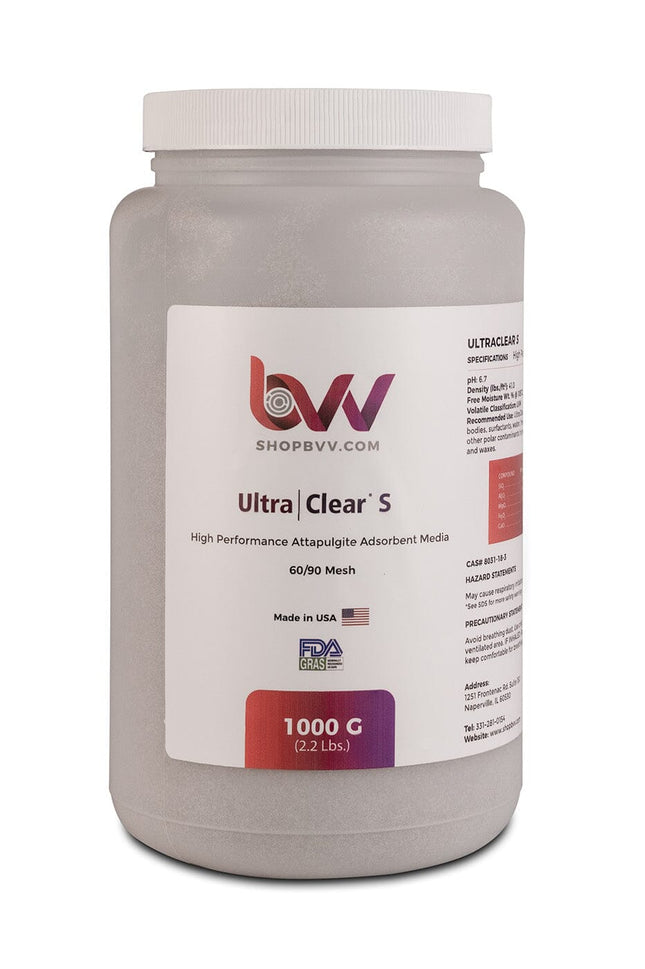
Ultra Clear S - Granular High Performance Bentonite for Bleaching & Decolorizing Edible Oils
Ultra:Clear® S 60/90 Mesh Made in USA, Food Grade Certified Ultra-Clear® S effectively removes color bodies, surfactants, water, free fatty acids, organic oxides, and other polar contaminants from a wide range of oils, liquids, and waxes. It is the Smallest particle size in the Ultra-Clear product line. UltraClear® S is a unique, naturally occurring attapulgite that has been thermally processed to provide hard, durable granules that won’t swell or breakdown in the presence of water. All Ultra-Clear products are classified as processing aids andhave Generally Recognized As Safe (GRAS) status from theFood and Drug Administration (FDA). At BVV™ we recommend 100g per lb. of biomass. We also use this media with layering techniques & can be used with BVV™ Silica Gel and BVV™ Neutral Activated Alumina for a sugar in the oven finish! Ultra-Clear® is manufactured in 4 granule sizes, 8/16, 16/30, 30/60 & 60/90 mesh sizes. Ultra-Clear® S is the smallest particle size and will offer the greatest surface area while remaining a High-Flow media for your extraction. See the technical data sheet for more information from the manufacturer. Ultra:Clear® S Food Grade Certificate Ultra:Clear® S Technical Data Sheet Ultra:Clear® S Safety Data Sheet
$13.00 - $2,100.00
You have seen 58 out of 58 products











